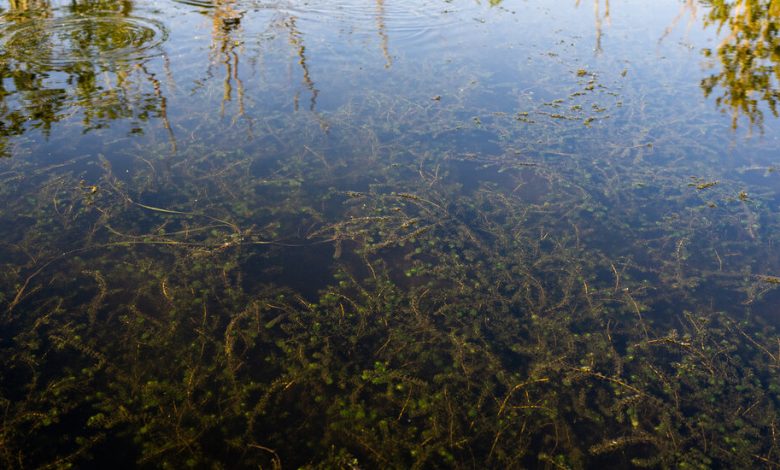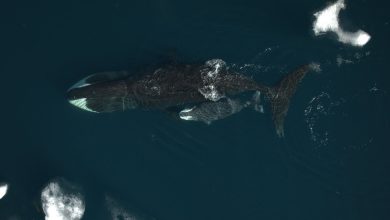Will Dyeing the Connecticut River Help Keep It Alive?

The Connecticut River faces a crisis: An aggressive invasive plant that grows in thick underwater mats is spreading swiftly.
It chokes out native plants, changes the water’s chemical balance and raises its temperature. It ensnares boaters and slows the river’s flow, which heightens flood risks and makes an ideal nursery for mosquitoes. And it is on the move: The plant, a new strain of hydrilla, was discovered in several other bodies of water in Connecticut this year.
“The rate of increase is really going through the roof,” said Jeremiah Foley, a scientist with the Connecticut Agricultural Experiment Station, as he steered a small research boat through one of the river’s tributaries near East Haddam, Conn., northeast of New Haven.
Government scientists are rushing to contain the hydrilla before it spreads even farther in the Connecticut River, which is the longest river in New England and flows through four states.
They are fighting back with an unlikely weapon: red tracer dye.
The dye will not harm the hydrilla. Instead, it is meant as a test run for herbicides the scientists plan to put into the river next year. They will track how quickly it dissipates in specific areas to decide how much herbicide to use.
Their goal is to find a sweet spot: enough herbicide to kill the hydrilla, but not enough to hurt native plants.
“We’re using that dye as a surrogate to inform us using as little herbicide as possible,” said Benjamin Sperry, a research biologist with the U.S. Army Engineer Research and Development Center who specializes in aquatic plants.
The scientists, many of whom work with the Army Corps of Engineers, sometimes start applying the dye before sunrise. It disperses quickly in the water, vanishing to the naked eye. But it leaves fluorescent traces that appear when scientists shine sensors into the water.
At the same time, scientists are studying this new strain of hydrilla — considered genetically distinct from other varieties found in the U.S. — to understand its growth patterns.
“We have to figure out how to kill it,” Dr. Foley said. “But we’ve also got to figure out how it grows.”
Hydrilla, many strains of which originated in Asia, first appeared in the American South decades ago before spreading through much of the country.
This outbreak was first identified in 2016. Since then, hydrilla has been found throughout the river, in Connecticut and up into Massachusetts, along an area that stretches at least 70 miles.
“It’s further north than it’s ever been,” Dr. Foley said, his hand on the tiller as he navigated the boat through the river. Around him, the tops of hydrilla plants broke the surface of the shallow water, almost like rumble strips on the sides of a highway. “And it’s more robust than it’s ever been.”
Scientists have spent decades fighting hydrilla in other states. And in New York, California, North Carolina and Indiana, herbicides have slowed its growth.
But the plant is a tough adversary.
It has no natural predators in the region and can alter a river’s pH balance or oxygen levels, which can disrupt the growth of native plants and animals.
In Connecticut, there is no hope for eradication anymore, Dr. Foley said. Instead, by killing the hydrilla with herbicide and educating boaters, scientists hope to beat back the infestation year after year.
Very few aquatic herbicides are approved by the Environmental Protection Agency. Those that are largely degrade or break down into nontoxic molecules, said Rob Richardson, an aquatic weed expert at North Carolina State University and a national expert in hydrilla, though there are still risks.
Researchers see the dye as a vital step to using the chemicals safely — and finding the right recipe.
“It’s basically like baking a cake,” Dr. Foley said. Using too much herbicide could “burn everything.” But using too little could leave the invasive plants charred, but alive.
Even environmental groups support a controlled chemical application: “They know that it’s necessary for this issue that can’t be solved any other way,” said Rhea Drozdenko, an advocate with the Connecticut River Conservancy.
But herbicides, however potent, are only a short-term fix to manage the hydrilla. Boaters need to be vigilant, too.
The infestation almost certainly started when someone dumped out a personal aquarium, scientists said.
And people are still spreading it — either unknowingly or uncaringly — as they move their boats between waterways without correctly cleaning, draining and drying them.
“This is ground zero,” Dr. Foley said as he pushed his boat off from a dock, raking the hydrilla away from his motor, the mist rising around him.
As he steered through the water, he repeatedly cut the power to rip off the plants by hand.
Some boaters and fishermen say that the government waited far too long to address the outbreak, which is affecting many marinas, including the Chester Boat Basin, about half an hour from the mouth of the river.
Steven Leonti, the marina manager, said hydrilla can be dangerous, and can stall out a motorboat that is struggling to maneuver in the tight quarters.
But kayakers have it worse. At low tide, “you’re literally just trying to push yourself through grass,” he said. “It’s that bad.”
It can be costly, too: The marina recently spent over $20,000 to rake mats of hydrilla out of the water and into dumpsters, Mr. Leonti said.
He felt he had no choice but to go at it manually. Without government permission, he said he was afraid to use a herbicide on his own and risk a fine.
“What are we supposed to do about it? Nothing?” he said. “It’s killing our river.”





